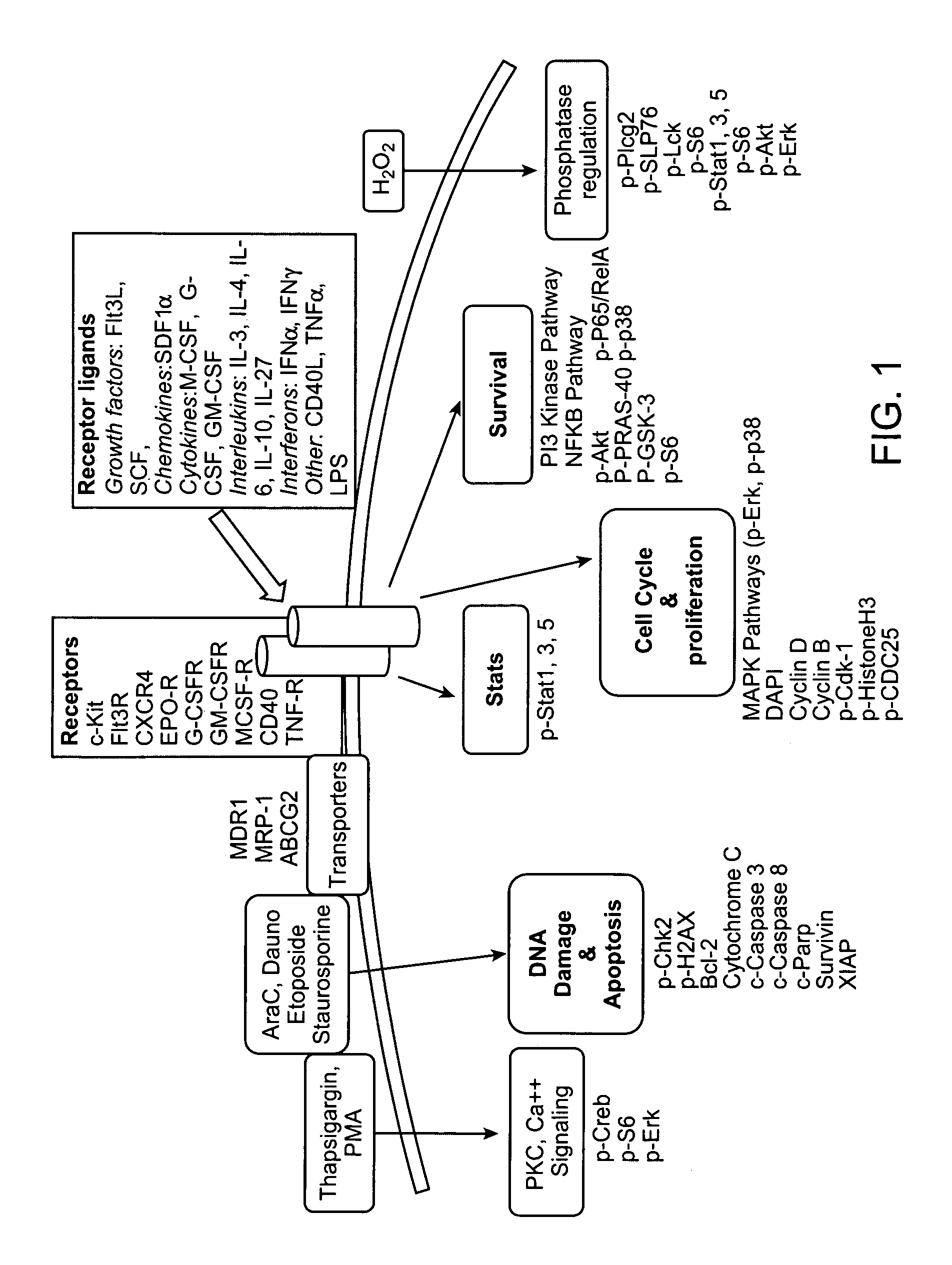Methods for diagnosis, prognosis and methods of treatment
a prognosis and treatment technology, applied in the field of diagnosis, prognosis and treatment methods, can solve the problems of increasing the risk of developing leukemia, affecting the survival rate of patients, and affecting the quality of life of patients, so as to achieve the effect of minimal residual diseas
- Summary
- Abstract
- Description
- Claims
- Application Information
AI Technical Summary
Benefits of technology
Problems solved by technology
Method used
Image
Examples
example 1
Materials and Methods
[0496]The present illustrative example represents how to analyze cells in one embodiment of the present invention. There are several steps in the process, such as the stimulation step, the staining step and the flow cytometry step. The stimulation step of the phospho-flow procedure can start with vials of frozen cells and end with cells fixed and permeabilized in methanol. Then the cells can be stained with an antibody directed to a particular protein of interest and then analyzed using a flow cytometer.
[0497]The materials used in this invention include thawing medium which comprises PBS-CMF+10% FBS+2 mM EDTA; 70 um Cell Strainer (BD); anti-CD45 antibody conjugated to Alexa 700 (Invitrogen) used at 1 ul per sample; propidium iodide (PI) solution (Sigma 10 ml, 1 mg / ml) used at 1 ug / ml; RPMI+1% FBS medium; media A comprising RPMI+1% FBS+1× Penn / Strep; Live / Dead Reagent, Amine Aqua (Invitrogen); 2 ml, 96-Deep Well, U-bottom polypropylene plates (Nunc); 300 ul 96-Ch...
example 2
[0516]Multi-parameter flow cytometric analysis was performed on peripheral blasts taken at diagnosis from 9 AML patients who achieved a complete response (CR) and 24 patients who were non-responders (NR) to one cycle of standard 7+3 induction therapy (100-200 mg / m2 cytarabine and 60 mg / m2 daunorubicin). The signaling nodes were organized into 4 biological categories: 1) Protein expression of receptors and drug transporters 2) Response to cytokines and growth factors, 3) Phosphatase activity, and 4) Apoptotic signaling pathways.
[0517]The data showed that expression of the receptors for c-Kit and FLT3 Ligand and the drug transporter ABCG2, were increased in patients who achieved an NR versus CR (data not shown). Readouts from the cytokine-Stat response panels and the growth factor-Map kinase and PI3-Kinase response panels (see Table 4) revealed increased signaling in blasts taken from NR patients versus blasts taken from patients who clinically responded to therapy. To determine the r...
example 3
[0525]An analysis of a heterogenous population of AML patients may be conducted as outlined above. The results may show the following. In some embodiments, univariate analysis is performed on relatively homogeneous clinical groups, such as patients over 60 years old, patients under 60 years old, de novo AML patients, and secondary AML patients. In other embodiments the groups may be molecularly homogeneous groups, such as Flt-3-ITD WT. For example, in patients over 60 years old, NRs may have a higher H2O2 response than CRs and / or a higher FLT3L response than CRs. In patients under 60, NRs may have a higher IL-27 response than CRs and / or CRs may induce apoptosis to Etoposide or Ara-C / Daunorubicin more than NRs. In de novo AML, CRs may induce apoptosis (cleaved PARP) in response to Etoposide or Ara-C / Daunorubicin, they may have higher total p-S6 levels than NRs, or NRs may have higher H2O2 response than CRs. In secondary AML, NRs may have higher H2O2 responses than CRs, NRs may have h...
PUM
| Property | Measurement | Unit |
|---|---|---|
| pore sizes | aaaaa | aaaaa |
| temperature | aaaaa | aaaaa |
| concentration | aaaaa | aaaaa |
Abstract
Description
Claims
Application Information
 Login to View More
Login to View More - R&D
- Intellectual Property
- Life Sciences
- Materials
- Tech Scout
- Unparalleled Data Quality
- Higher Quality Content
- 60% Fewer Hallucinations
Browse by: Latest US Patents, China's latest patents, Technical Efficacy Thesaurus, Application Domain, Technology Topic, Popular Technical Reports.
© 2025 PatSnap. All rights reserved.Legal|Privacy policy|Modern Slavery Act Transparency Statement|Sitemap|About US| Contact US: help@patsnap.com



